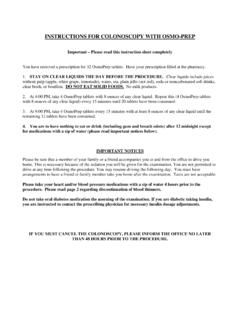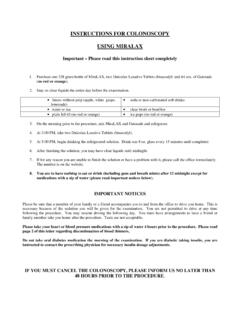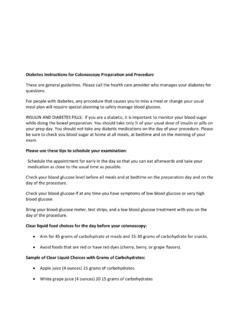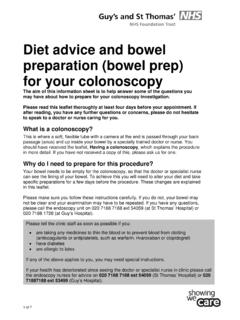Transcription of INSTRUCTIONS FOR FLEXIBLE SIGMOIDOSCOPY
1 INSTRUCTIONS FOR FLEXIBLE SIGMOIDOSCOPY Important Please read this instruction sheet completely 1. Purchase one bottle of Magnesium Citrate and two Fleet cleansing enemas (green and white box) at any pharmacy. 2. Follow a clear liquid diet for lunch and dinner the day before the procedure such as: jello (no red jello), clear apple juice, ginger ale, 7-Up, broth, bouillon, tea or coffee. Sugar is permitted. No milk products or alcoholic beverages. 3. Drink a bottle of Magnesium Citrate at 5:30 the night before the procedure. Between 7:00 and bedtime, drink at least 2 quarts of water. 4. Nothing to eat or drink (including gum and breath mints) after 12 midnight. 5. Two Fleet cleansing enemas three hours prior to the procedure. Take first enema, evacuate. Wait 20 minutes.
2 Take second enema. Please take your heart and/or blood pressure medications with a sip of water 4 hours prior to the procedure. Please read page 2 regarding discontinuation of blood thinners. Do not take oral diabetes medication the morning of the examination. If you are a diabetic taking insulin, you are instructed to contact the prescribing physician for necessary insulin dosage adjustments. IF YOU MUST CANCEL THIS EXAMINATION, PLEASE INFORM US NO LATER THAN 48 HOURS PRIOR TO THE PROCEDURE. PRE-PROCEDURAL INSTRUCTIONS MEDICATION RESTRICTIONS 1. If you take anticoagulants or blood thinners , please speak with your cardiologist or family physician before stopping these medications. Anticoagulants: Aggrenox - 5 days Plavix - 7 days Ticlid - 7 days Coumadin - 5 days Pletal - 3 days Trental - 7 days Lovenox - 24 hours 2.
3 If you take aspirin or aspirin-containing medications for heart problems, circulation problems or are unsure, please contact your cardiologist or family physician on whether or not these medications should be held. If you DO NOT have heart or circulation problems, stop aspirin and all aspirin-containing medications FIVE (5) days before your procedure. Aspirin-containing medications: Ascripton Ecotrin Fiorinal Percodan Bayer Empirin Lortab ASA Soma Compound Bufferin Enteric-coated aspirin Momentum St. Joseph Aspirin Darvon Compound 65 Excedrin Norgesic Forte P-A-C Wygesic 3.
4 Stop ALL NON-ASPIRIN AND NON-STEROIDAL PAIN RELIEVERS THREE (3) DAYS before your procedure. Non-aspirin containing medications: Advil Daypro Ketoralac Relafen Aleve Diclofenac Lodine Sulindac Anaprox Dolobid Meloxicam Trilisate Ansaid Feldene Mobic Vicoprofen Arthrotec Flurbiprofen Motrin Voltaren Catafalm Ibuprofen Naprosyn Clinoril Indocin Naproxen 4. There are NO RESTRICTIONS on the following pain medications: Acetaminophen (Tylenol) containing products (Tylenol, Darvocet, etc.), as well as: Avinza Fioricet Neurontin Ultracet Baclofen Flexeril Oxy IR Ultram Bextra Kadian Oxycontin Valium Celebrex Lorcet Pamelor Vicoden Darvocet Lortab Panadol Zanaflex Duragesic Patches Methadone Percocet Zonegram Elavil MS Contin Percogesic Excedrin-Aspirin Free MSIR Trileptal If you have any questions, please call our office about your medications.
5 What is FLEXIBLE SIGMOIDOSCOPY ? FLEXIBLE SIGMOIDOSCOPY is a procedure that enables your physician to examine the lining of the rectum and a portion of the colon (large bowel) by inserting a FLEXIBLE tube that is about the thickness of your finger into the anus and advancing it slowly into the rectum and lower part of the colon. What preparation is required? The rectum and lower colon must be completely empty of waste material for the procedure to be accurate and complete. Your physician will give you detailed INSTRUCTIONS regarding the cleansing routine to be used. What about my current medications? Most medications can be continued as usual. You should inform your physician of all current medications as well as any allergies to medications several days prior to the examination.
6 However, drugs such as aspirin or anticoagulants (blood thinners) are examples of medications whose use should be discussed with your physician. What can be expected during FLEXIBLE SIGMOIDOSCOPY ? FLEXIBLE SIGMOIDOSCOPY is usually well tolerated. There is often a feeling of pressure, bloating or cramping at various times during the procedure. You will be lying on your side while the sigmoidoscope is advanced through the rectum and colon. As the instrument is withdrawn, the lining of the intestine is carefully examined. The procedure usually takes anywhere from 5 to 15 minutes. What if the FLEXIBLE SIGMOIDOSCOPY shows something abnormal? If the doctor sees an area that needs evaluation in greater detail, a biopsy (sample of the colon lining) may be obtained and submitted to a laboratory for greater analysis.
7 If polyps (growths from the lining of the colon which vary in size) are found, they can be biopsied, but usually are not removed at the time of the SIGMOIDOSCOPY . Polyps are of varying types: certain benign polyps, knows as adenomas are potentially precancerous. Certain other polyps ( hyperplastic by biopsy analysis) may not require removal. Your doctor will likely request that you have a colonoscopy (a complete examination of the colon) to remove any large polyp that is found or any small polyp that is adenomatous after biopsy analysis. What happens after a FLEXIBLE SIGMOIDOSCOPY ? After SIGMOIDOSCOPY , the physician will explain the results to you. You may have some mile cramping or bloating sensation because of the air that has been passed into the colon during the examination.
8 This will disappear quickly with the passage of gas. You should be able to eat and resume your normal activities after leaving your doctor s office or the hospital. What are possible complications of FLEXIBLE SIGMOIDOSCOPY ? FLEXIBLE SIGMOIDOSCOPY and biopsy are generally safe when performed by physicians who have been specially trained and are experienced in these endoscopic procedures. Possible complications after FLEXIBLE SIGMOIDOSCOPY are rare. It is important for you to recognize early signs of any possible complication. Contact your physician if you notice any of the following symptoms: severe abdominal pain, fever and chills, or rectal bleeding of more than one half cup. It is important to note that rectal bleeding can occur even several days after the biopsy.
9 Rev 04/10


![LIBERAL BLAND DIET II 6[1].29.06 - Gastroenterology Group](/cache/preview/6/5/2/8/e/d/1/d/thumb-6528ed1dfc1a99fdd566db67dc3ed846.jpg)



